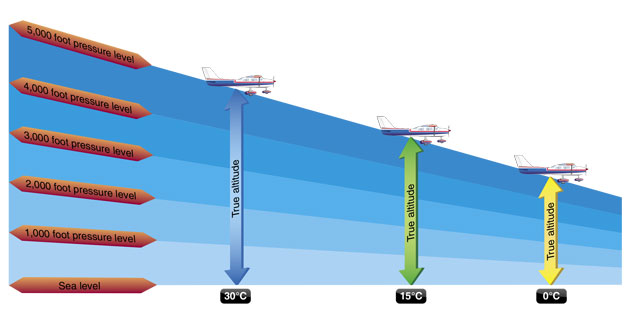
Your IFR rental airplane has sat idle since last week, and as you open the cabin door and peer inside, one of the things that catch your eye is the altimeter, its indication way off because it is still pegged to the days-old pressure setting.
Reflexively, you reset the altimeter to the field elevation, and turn to other matters. Do you make a point to note the error in indicated altitude and correlate it with the erroneous pressure setting? Is the current altimeter setting higher or lower than when the aircraft last flew? Was the erroneous altitude indication higher or lower than the field elevation?
Those are the kinds of questions you would usually confront in ground school or home study of aircraft instruments. Depending on how the question is posed, specific scenarios can be confusing.
Some guidance comes from the old saying you learned as a student pilot that “when flying from a high to a low, look out below.” But that doesn’t cover everything: What hazard exists when the temperature deviates so much from standard-atmosphere values that an altimeter—even one set to the proper pressure—can’t be trusted?
Here’s a clue: Unlike in summer when high temperatures create performance-robbing high density altitude conditions, cold air is the villain of this piece, actually impugning an altimeter’s credibility.
“If terrain or obstacle clearance is a factor in selecting a cruising altitude, particularly in mountainous terrain, remember to anticipate that a colder than-standard temperature places the aircraft lower than the altimeter indicates,” explains page 7-4 of the Pilot’s Handbook of Aeronautical Knowledge. “Therefore, a higher indicated altitude may be required to provide adequate terrain clearance.”
A fine illustration of this idea appears on the same page of the handbook, and is shown at the top of this page.
Well, wait. You can’t just fly at a higher indicated altitude than your clearance requires—and what happens in the approach phase when those frigid-weather altimeter errors erode your obstacle clearance protection?
As AOPA reported earlier this month, the FAA publishes a procedure for calculating the necessary extra altitude to add, and lists the approaches to cold weather restricted airports on which you must do so.
To remind you of the need to keep that requirement in mind, the FAA handbook offers an updated version of the old reminder. It goes, “From a high to a low, or hot to cold, look out below.”



